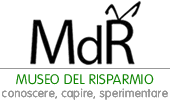Developing effective financial education programmes requires a mixture of skills: thorough knowledge of economics and finance, ability to communicate in an easy and engaging manner and a command of the most advanced teaching methods.
Conceived as a unique education entertainment place where technology and interactivity are used to surprise and entertain visitors, the Museum of Saving is largely based on audio-visual material such as fictional documentary, cartoons, interviews, role play, video games and dramatic animations, further diversified by connections with literature and cinema.
The fundamental idea is to convey complex financial concepts by means of enjoyable and aesthetically refined materials to mitigate visitors’ deep-rooted prejudices. Video games are a great, fear-free way to experiment; they provide freedom to evaluate different outcomes and to understand the rules of wise money management, so long as the user is guided correctly.
This game-based learning approach is particularly effective when applied to financial education as it allows the user to overcome the typical shortcomings of traditional educational programmes. For instance, the latter often do not fully consider personal motivation, emotional needs and social practices, and tend to be centred on the acquisition of factual knowledge whilst neglecting financial decision-making and behaviour[1].
The Museum of Saving provides several examples of different approaches to financial education.
Given the perceived gender gap in financial literacy, the workshop “Risk is a woman’s job” has been open to groups of women, since 2016, to raise their awareness on self-limiting beliefs, which prevent them from investing and acquiring an attitude less adverse to risk. The workshop includes an education-entertainment session focused on some common beliefs about risk and a financial education session on volatility, diversification, risk/return relationship.
In 2017, to stimulate interest in money management and budgeting, the museum launched a call for action “That genius of my grandmother!” through social media for collecting a large number of budget books forgotten in the attic. A selection of ancient grandmothers’ budget books, filled with family memories, was put on display in a public exhibition with the aim of showing how women deal with saving and budgeting issues.
Recently the Welcome-ED project has been put together to address the financial education needs of highly vulnerable groups such as migrants and convicts. The workshops are organised in cooperation with local associations and cultural mediators with the aim of encouraging discussion and teaching on how to keep track of financial entry and exit items by playing games and completing simple tests.
The same approach is applied in the creation of financial education booklets. For example, the guide “Pocket money and tips” advises parents on how to give allowances and suggests practical activities to teach children how to handle money responsibly and sensibly.
Educational APPs represent another innovative teaching opportunity. In this regard, the Museum on Savings, designed an education game Be prime minister, where the player has to step into the shoes of a Prime Minister and try to manage current investment expenditures in a fantasy island.
[1] ‘Instructional integration of digital learning games in financial literacy education’, C. Aprea, J. Schultheis, K. Stolle https://www.researchgate.net/publication/321137033_Instructional_Integration_of_Digital_Learning_Games_in_Financial_Literacy_Education
tag: Edutainment at the service of financial literacy
